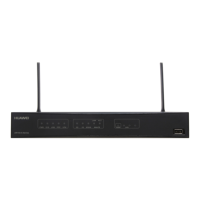#
sysname RouterA
#
vlan 100
#
dhcp enable
#
dhcp server group dhcpgroup1
dhcp-server 100.10.10.1
#
interface Vlanif100
ip address 20.20.20.1 255.255.255.0
dhcp select relay
dhcp relay server-select dhcpgroup1
#
interface Ethernet 2/0/0
port hybrid pvid vlan 100
port hybrid untagged vlan 100
#
ip route-static 0.0.0.0 0.0.0.0 100.10.20.2
#
return
Configuration file of RouterB
#
sysname RouterB
#
vlan batch 20
#
dhcp enable
#
ip pool pool1
network 20.20.20.0 mask 255.255.255.0
gateway-list 20.20.20.1
#
interface Ethernet3/0/0
ip address 100.10.10.1 255.255.255.0
dhcp select global
#
ip route-static 0.0.0.0 0.0.0.0 100.10.10.2
#
return
6.9.4 Example for Configuring the DHCP and BOOTP Clients
This section describes how to configure the DHCP and BOOTP clients.
Networking Requirements
As shown in Figure 6-8, Router A functions as a DHCP client; Router B functions as a BOOTP
client; Router C functions as a DHCP server. Router A dynamically obtains an IP address, a
DNS server address, and a gateway address from Router C. Router B obtains an IP address from
an IP-MAC binding entry, a DNS server address, and a gateway address from Router C
functioning as a DHCP server.
NOTE
AR150/200 is RouterA, RouterC, or RouterD.
Huawei AR150&200 Series Enterprise Routers
Configuration Guide - IP Service 6 DHCP Configuration
Issue 02 (2012-03-30) Huawei Proprietary and Confidential
Copyright © Huawei Technologies Co., Ltd.
167

